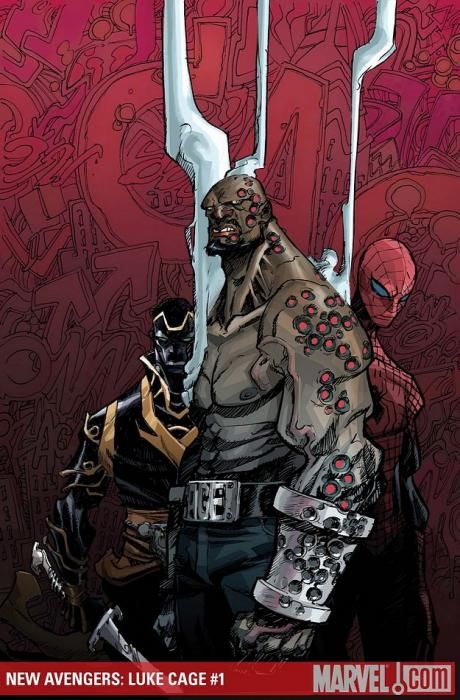The main problem with "New Avengers: Luke Cage" #1 is that it reads like the first issue of every "Marvel Noir" series that's come out over the past year or two. The hero investigates a crime or a mystery, a medium-tough bruiser comes in to push the hero around and get him to back off, and the hero is inspired to pursue the investigation further, foreshadowing a battle with the big boss that will inevitably happen at the end.
In this incarnation, Luke Cage plays the hero, Hammerhead is the bruiser, and Mr. Negative is the big boss.
It's a stale story, and if it's like the rest of Marvel's four issue miniseries of late, then we can predict the beats of the next three issues as well.
But within that tried-and-true (if overused) structure, John Arcudi does some nice work with Luke Cage and company. He gives us just enough of Cage-and-Jessica at the beginning to make us understand how high the stakes are -- that he has a family to take care of, a family that wants him to come back from his trip to Philadelphia with all of his body parts intact. Though there's not a whole lot of dialogue in this issue, Arcudi uses it effectively. The opening scene has the right mix of New Avengers-ish banter, and the final scene has a surprise in the closing lines. And, honestly, it's nice to see Luke Cage in some street-level crime action, even if it is in the service of a story that seems to be a bit cliche.
In the hands of an average artist, this would be an average Marvel issue.
But Eric Canete brings something special to the story, and he alone bumps it from a two-and-a-half star comic to a three-and-a-half star one. He does neglect to properly introduce Hammerhead -- without the dialogue, I'm not sure I would have known who he was supposed to be at first -- but this is a dynamic-looking issue from start to finish. Whether it's the opening battle with a rowdy Hippo-man or the cribside scenes inside Luke's home, Canete makes some powerful images. His unbelievably expressive line, so fluid, so impressionistic, adds life to this comic and makes it stand out among the more stoically illustrative superhero comics that tend to clutter the stands. When the fight between Luke Cage and Hammerhead occurs, Canete radically shifts the size of the characters, depicting whoever is winning the battle as twice the size of whoever is losing, even though Hammerhead and Cage are roughly the same height normally. Canete even gives us one panel of Cage making a fist and Hammerhead taking three blows to the head, without ever showing the actual punch. It's a panel I've never seen in a comic before, and it shows the fury and impact of the action, without stopping to choreograph every move. It's pretty great.
I'd like to think Arcudi will break out of this obvious structure that he seems to have undertaken, but, even if he doesn't, we'll still get to look at Eric Canete doing his thing for the next three issues. We could do a whole lot worse than that.

